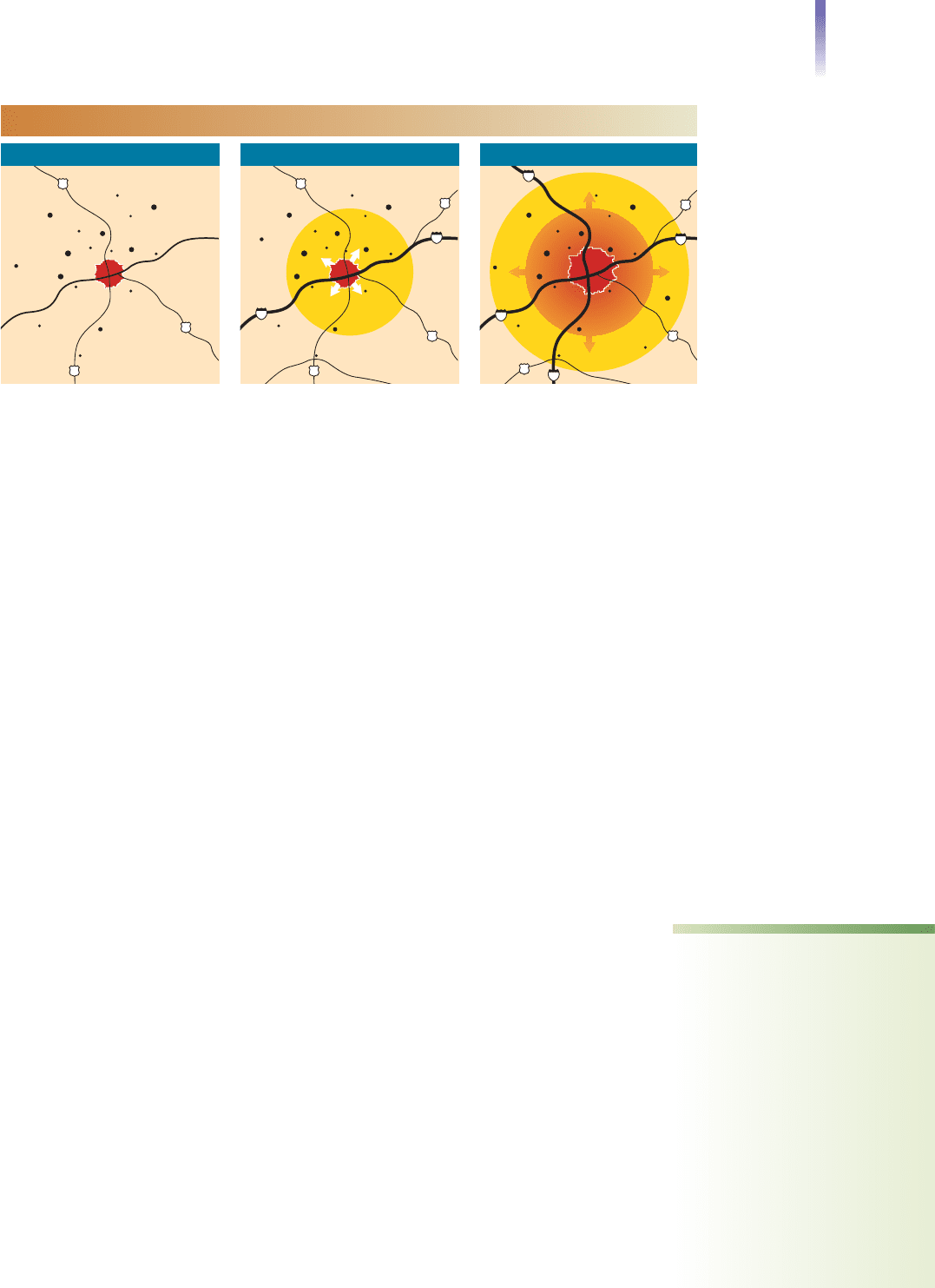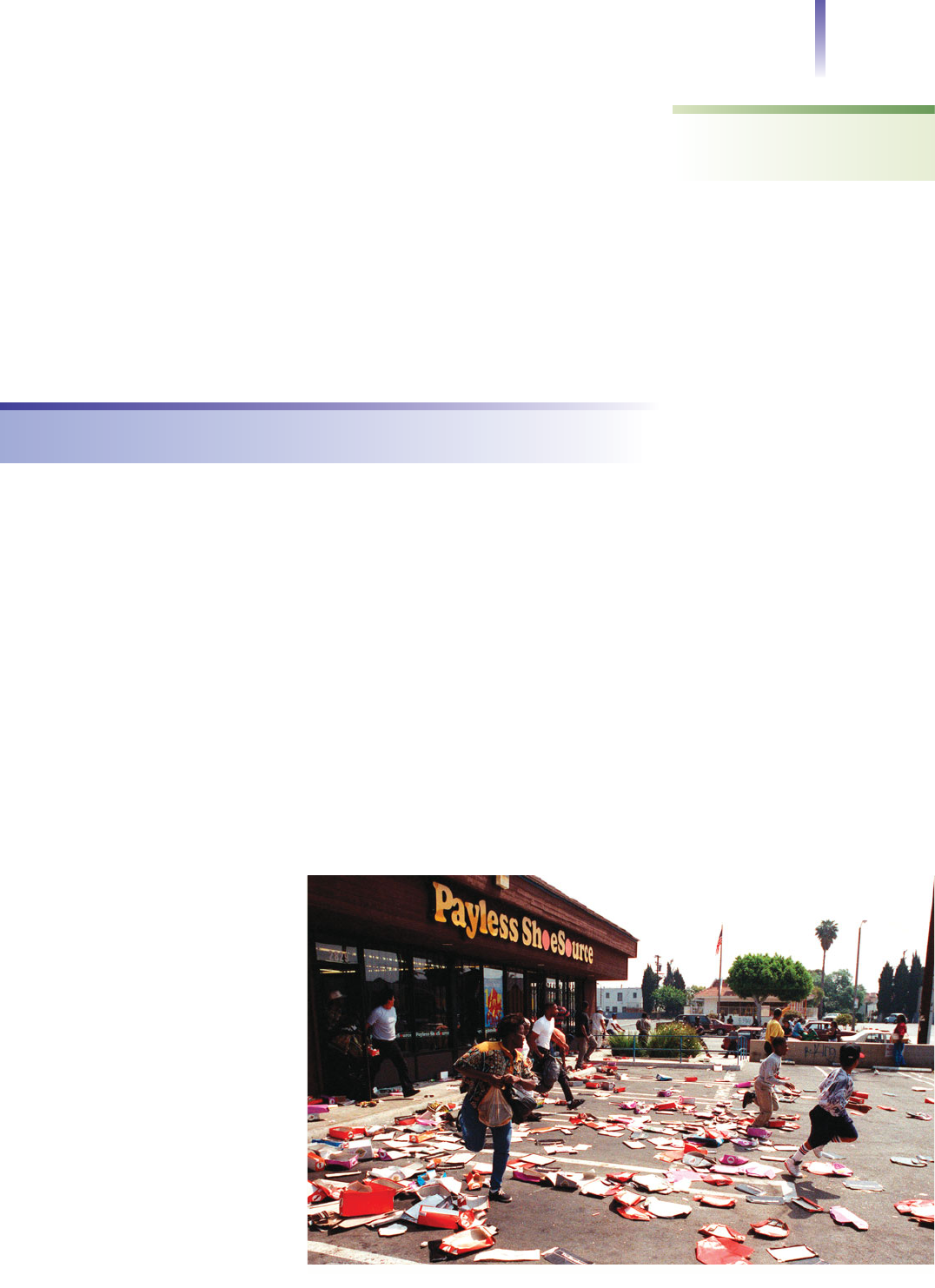Henslin James M. Sociology: A Down to Earth Approach
Подождите немного. Документ загружается.


problem area on a map and refuse to make loans for housing or businesses there. This
disinvestment (withdrawal of investment) pushed these areas into further decline. Youth
gangs, muggings, and murders are common in these areas, but good jobs are not. All are
woven into this process of disinvestment.
The globalization of capitalism has also left a heavy mark on U.S. cities. As we re-
viewed in Chapter 14, to compete in the global market, many U.S. industries aban-
doned local communities and moved their factories to countries where labor costs are
lower. This process, called deindustrialization, made U.S. industries more competitive,
but it eliminated millions of U.S. manufacturing jobs. Lacking training in the new in-
formation technologies, many poor people are locked out of the benefits of the postin-
dustrial economy that is engulfing the United States. Left behind in the inner cities,
many live in despair.
The Potential of Urban Revitalization
Social policy usually takes one of two forms. The first is to tear down and rebuild—something
that is fancifully termed urban renewal. The result is the renewal of an area—but not for the
benefit of its inhabitants. Stadiums, high-rise condos, luxury hotels, and boutiques replace
run-down, cheap housing. Outpriced, the area’s inhabitants are displaced into adjacent areas.
The second is some sort of enterprise zone, a designated area of the city that offers eco-
nomic incentives, such as reduced taxes, to businesses that move into it. Although the in-
tention is good, the usual result is failure. Most businesses refuse to locate in high-crime
areas. Those that do relocate pay a high price for security and losses from crime, which
can eat up the tax savings. If workers are hired from within the problem area and the jobs
pay a decent wage, which most do not, the workers move to better neighborhoods—which
doesn’t help the area (Lemann 1994). After all, who chooses to live with the fear of violence?
A form of the enterprise zone, called Federal Empowerment Zones, has brought some
success. In addition to tax breaks, this program offers low-interest loans targeted for
redeveloping an area. It is, in effect, the opposite of disinvestment, which devastates
areas. The Down-to-Earth Sociology box on page 612 featured the renaissance of
Harlem. Stimulating this change was the designation of Harlem as a Federal Empow-
erment Zone. The economic incentives lured grocery stores, dry cleaners, and video
stores, attracting urbanites who expect such services. As middle-class people moved
back in, the demand for more specialty shops followed. A self-feeding cycle of invest-
ment and hope began, replacing the self-feeding cycle of despair, crime, and drug use
that accompanies disinvestment.
U.S. cities can be revitalized and made into safe and decent places to live. There is noth-
ing in the nature of cities that turns them into dangerous slums. If U.S. cities are to change,
Urban Problems and Social Policy 621
50 years ago
25 years ago
Now
At first, the city and
surrounding villages grew
independentl
y
.
As city dwellers fled urban
decay, they created a ring
of suburbs.
As middle-class flight continues
outward, urban problems are
arriving in the outer rings.
FIGURE 20.14 Urban Growth and Urban Flight
disinvestment the with-
drawal of investments by finan-
cial institutions, which seals the
fate of an urban area
deindustrialization the
process of industries moving
out of a country or region
urban renewal the rehabili-
tation of a rundown area,
which usually results in the
displacement of the poor who
are living in that area
enterprise zone the use of
economic incentives in a desig-
nated area to encourage in-
vestment

OTHER NUMBERS
Number of years it takes for
population to double
MOST
INDUSTRIALIZED
NATIONS
LEAST
INDUSTRIALIZED
NATIONS
Annual population
increase of the Least
Industrialized Nations
1960s
%
NOW
%
Number of the
world’s cities with over
1 million residents
1975
2025
World per capita
production of food
W
orld pe
r
r
c
a
p
roductio
n
n
o
f
Number of the
world’s cities with over
10 million residents
1950 NOW
World population
AT THE BIRTH
OF CHRIST
MILLION
ALMOST
NOW
BILLION
they need to become top agenda items of the U.S. government. Ade-
quate resources in terms of money and human talents must be focused
on overcoming urban woes. That we are beginning to see success in
Harlem, Chicago’s North Town, and even in formerly riot-torn East
Los Angeles indicates that the transformation can be brought about.
Replacing old buildings with new ones, however, is not the an-
swer. Instead, we need to apply sociological principles of building
community. Here are three guiding principles suggested by sociolo-
gist William Flanagan (1990):
Scale. Regional and national planning is necessary. Local jurisdic-
tions, with their many rivalries, competing goals, and limited re-
sources, end up with a hodgepodge of mostly unworkable solutions.
Livability. Cities must be appealing and meet human needs,
especially the need of community. This will attract the middle
classes into the city, which will increase its tax base. In turn, this
will help finance the services that make the city more livable.
Social justice. In the final analysis, social policy must be evaluated
by how it affects people. “Urban renewal” programs that displace
the poor for the benefit of the middle class and wealthy do not pass
this standard. The same would apply to solutions that create “liv-
ability” for select groups but neglect the poor and the homeless.
Most actions taken to solve urban problems are window dressings for politicians who
want to appear as though they are doing something constructive. The solution is to avoid
Band-Aids that cover up the problems that hurt our quality of life and to address their root
causes—poverty, poor schools, crimes of violence, lack of jobs, and an inadequate tax base
to provide the amenities that enhance our quality of life and attract people to the city.
622 Chapter 20 POPULATION AND URBANIZATION
U.S. suburbs were once unplanned, rambling affairs that
took irregular shapes as people moved away from the
city.Today’s suburbs tend to be planned to precise details
even before the first resident moves in.This photo is of a
suburb outside of Venice, CA.
By the Numbers: Then and Now

Summary and Review 623
primary impetus to the development of cities was the in-
vention of the plow. After the Industrial Revolution stim-
ulated rapid transportation and communication, cities
grew quickly. Today urbanization is so extensive that
some cities have become metropolises, dominating the
areas adjacent to them. Some metropolises spill over into
each other, forming a megalopolis. Pp. 605–611.
What is the rural rebound?
As people flee cities and suburbs, the population of most
U.S. rural counties is growing. This is a fundamental de-
parture from a trend that had been in place for a couple
of hundred years. Pp. 611–613.
Models of Urban Growth
What models of urban growth have been proposed?
The primary models are concentric zone, sector, multi-
ple-nuclei, and peripheral. These models fail to account
for ancient and medieval cities, many European cities,
cities in the Least Industrialized Nations, and urban plan-
ning. Pp. 613–615.
City Life
Who lives in the city?
Some people experience alienation in the city; others find
community in it. What people find depends largely on
their background and urban networks. Five types of peo-
ple who live in cities are cosmopolites, singles, ethnic vil-
lagers, the deprived, and the trapped. Pp. 615–619.
Urban Problems and Social Policy
Why have U.S. cities declined?
Three primary reasons for the decline of U.S. cities are
suburbanization (as people moved to the suburbs, the
tax base of cities eroded and services deteriorated),
disinvestment (banks withdrawing their financing), and
deindustrialization (which caused a loss of jobs).
Pp. 620–621.
What social policy can salvage U.S. cities?
Three guiding principles for developing urban social pol-
icy are scale, livability, and social justice. Pp. 621–622.
SUMMARY and REVIEW
A Planet with No Space for Enjoying Life?
What debate did Thomas Malthus initiate?
In 1798, Thomas Malthus analyzed the surge in Europe’s
population. He concluded that the world’s population will
outstrip its food supply. The debate between today’s New
Malthusians and those who disagree, the Anti-Malthusians,
continues. Pp. 592–595.
Why are people starving?
Starvation is not due to a lack of food in the world, for
there is now more food for each person in the entire world
than there was fifty years ago. Rather, starvation is the re-
sult of a maldistribution of food, which is primarily due
to drought and civil war. Pp. 595–597.
Population Growth
Why do people in the poor nations have
so many children?
In the Least Industrialized Nations, children are often
viewed as gifts from God. In addition, they cost little to
rear, contribute to the family income at an early age, and
provide the parents’ social security. These are powerful
motivations to have large families. Pp. 597–601.
What are the three demographic variables?
To compute population growth, demographers use
fertility, mortality, and migration. They follow the basic
demographic equation, births minus deaths plus net mi-
gration equals the growth rate. Pp. 601–603.
Why is forecasting population difficult?
A nation’s growth rate is affected by unanticipated vari-
ables—from economic cycles, wars, and famines to indus-
trialization and government policies. Pp. 603–605.
The Development of Cities
How are cities related to farming
and the Industrial Revolution?
Cities can develop only if there is an agricultural surplus
large enough to free people from food production. The
THINKING CRITICALLY ABOUT Chapter 20
1. Do you think that the world is threatened by a population
explosion? Use data from this chapter to support your
position.
2. Why do people find alienation or community in the city?
3. What are the causes of urban problems, and what can we
do to solve those problems?

Collective Behavior and
Social Movements
21
Chapter

he news spread like wildfire. A police officer
had been killed. In just twenty minutes, the
white population was armed and heading for the cabin.
Men and mere boys, some not more than 12 years old, carried rifles,
shotguns, and pistols.
The mob, now swollen
to about four hundred, sur-
rounded the log cabin. Tying
a rope around the man’s neck,
they dragged him to the cen-
ter of town. While the men argued about the best way to kill him,
the women and children shouted their advice—some to hang him,
others to burn him alive.
Someone pulled a large wooden box out of a store and placed
it in the center of the street. Others filled it with straw. Then they
lifted the man, the rope still around his neck, and shoved him head
first into the box. One of the men poured oil over him. Another lit
a match.
As the flames shot upward, the man managed to lift himself
out of the box, his body a mass of flames. Trying to shield his face
and eyes from the fire, he ran the length of the rope, about twenty
feet, when someone yelled, “Shoot!” In an instant, dozens of shots
rang out. Men and boys walked to the lifeless body and emptied
their guns into it.
They dragged the man’s body back to the burning box, then
piled on more boxes from the stores, and poured oil over them.
Each time someone threw on more oil and the flames shot upward,
the crowd roared shouts of approval.
Standing about seventy-five feet away, I could smell the poor
man’s burning flesh. No one tried to hide their identity. I could
clearly see town officials help in the burning. The inquest, dutifully
held by the coroner, concluded that the man met death “at the
hands of an enraged mob unknown to the jury.” What else could
he conclude? Any jury from this town would include men who had
participated in the man’s death.
They dug a little hole at the edge of the street, and dumped in
it the man’s ashes and what was left of his body.
The man’s name was Sam Pettie, known by everybody to be
quiet and inoffensive. I can’t mention my name. If I did, I would
be committing suicide.
—Based on a May 1914 letter to The Crisis
T
One of the men poured
oil over him.Another
lit a match.
625
Texas

Collective Behavior
Why did people in this little town “go mad”? These men—and the women who shouted
suggestions about how to kill the captured man—were ordinary, law-abiding citizens.
Even some of the “pillars of the community” joined in the vicious killing of Sam Pettie,
who may well have been innocent.
Lynching is a form of collective behavior, actions by a group of people who bypass the
usual norms governing their behavior and do something unusual (Turner and Killian
1987; Harper and Leicht 2002). Collective behavior is a broad term. It includes not only
such violent acts as lynchings and riots but also rumors, panics, fads, and fashions. Before
examining its specific forms, let’s look at theories that seek to explain collective behavior.
Early Explanations:The Transformation
of the Individual
When people can’t figure something out, they often resort to using “madness” as an explana-
tion. People may say, “She went ‘off her rocker’—that’s why she drove her car into the river.”
“He must have ‘gone nuts,’ or he wouldn’t have shot into the crowd.” Early explanations of
collective behavior were linked to such assumptions. Let’s look at how these ideas developed.
How the Crowd Transforms the Individual
The study of collective behavior began when Charles Mackay (1814–1889), a British
journalist, noticed that “country folks,” who ordinarily are reasonable sorts of people,
sometimes “went mad” and did “disgraceful and violent things” when they formed a
crowd. The best explanation Mackay (1852) could come up with was that people had a
“herd mentality”—they were like a herd of cows that suddenly stampede.
About fifty years later, Gustave LeBon (1841–1931), a French psychologist, built on
this initial idea. In an 1895 book, LeBon stressed how people feel anonymous in crowds,
less accountable for what they do. Some even develop feelings of invincibility and come
to think that they can do almost anything. A collective mind develops, he said, and people
are swept up by almost any suggestion.
Then contagion, something like mass
hypnosis, takes over, releasing the de-
structive instincts that society so care-
fully represses.
Robert Park (1864–1944), a U.S. so-
ciologist who studied in Germany and
wrote a 1904 dissertation on the nature
of the crowd, was influenced by LeBon
(McPhail 1991). After Park joined the
faculty at the University of Chicago, he
added the ideas of social unrest and cir-
cular reaction. He said,
Social unrest . . . is transmitted from one
individual to another . . . so that the man-
ifestations of discontent in A [are] commu-
nicated to B, and from B reflected back to
A. (Park and Burgess 1921)
Park used the term circular reac-
tion to refer to this back-and-forth
communication. Circular reaction, he
626 Chapter 21 COLLECTIVE BEHAVIOR AND SOCIAL MOVEMENTS
collective behavior extraor-
dinary activities carried out by
groups of people; includes
lynchings, rumors, panics, urban
legends, and fads and fashions
collective mind Gustave
LeBon’s term for the tendency
of people in a crowd to feel,
think, and act in extraordinary
ways
circular reaction Robert
Park’s term for a back-and-
forth communication among
the members of a crowd
whereby a “collective impulse”
is transmitted
Race relations in the United States have gone through many stages, some of them very tense.
This photo was taken in Birmingham, Alabama, in 1963, at the height of the Civil Rights
Movement.The fire department is dispersing demonstrators who are protesting segregation.

said, creates a “collective impulse” that comes to “dominate all members of the crowd.”
If “collective impulse” sounds just like LeBon’s “collective mind,” that’s because it re-
ally is. As noted, Park was influenced by LeBon, and his slightly different term did not
change the basic idea at all.
The Acting Crowd
Herbert Blumer (1900–1987), who studied under Park, synthesized LeBon’s and Park’s
ideas. As you can see from Figure 21.1, Blumer (1939) identified five stages that precede
what he called an acting crowd, an excited group that moves toward a goal. This model
still dominates today’s police manuals on crowd behavior (McPhail 1989). Let’s apply it
to the killing of Sam Pettie.
1. A background of tension or unrest. At the root of collective behavior is a background
condition of tension or unrest. Disturbed about some condition of society, people
become apprehensive. This makes them vulnerable to rumors and suggestions. Sam
Pettie was killed during the early 1900s. At this time, southern life was in upheaval.
With the country industrializing, millions of Americans were moving from farm to
city in search of jobs, and from South to North. Left behind were many poor, rural
southerners, white and black, who faced a bleak future. In addition, African Americans
were questioning the legitimacy of their low status and deprivation.
2. Exciting event. An exciting event occurs, one so startling that people become preoc-
cupied with it. In this instance, that event was the killing of a police officer.
3. Milling. Next comes milling, people standing or walking around, talking about the
exciting event. A circular reaction then sets in. Picking up cues about the “right” way
to think and feel, people reinforce them in one another. Members of the mob that
killed Sam Pettie milled only a short time, but while they did so they became increas-
ingly agitated as they discussed the officer’s death.
4. A common object of attention. In this stage, people’s attention becomes riveted on
some aspect of the event. They get caught up in the collective excitement. In this
case, people’s attention turned to Sam Pettie. Someone may have said that he had
been talking to the officer or that they had been arguing.
Early Explanations:The Transformation of the Individual 627
1.
Social
unrest
Acting
crowd
5.
Common
impulses
4.
Common
object
3.
Milling
behavior
2.
Exciting
event
Social
contagion
Collective
excitement
Circular
reaction
Collective
excitement
Circular
reaction
Circular
reaction
FIGURE 21.1 Blumer’s Model of How an Acting Crowd Develops
Source: Based on McPhail 1991:11.
acting crowd an excited
group of people who move
toward a goal
milling a crowd standing or
walking around as they talk
excitedly about some event

5. Common impulses. People get the feeling that they are in agreement about what should
be done. These common impulses are stimulated by social contagion, a sense of excite-
ment that is passed from one person to another. In this instance, people concluded that
only the killer’s immediate death would be adequate vengeance.
Acting crowds aren’t always negative or destructive, as this one was. Some involve spon-
taneous demonstrations directed against oppression. Nor are they all serious, for students
having a food fight in a cafeteria are also acting crowds.
The Contemporary View:
The Rationality of the Crowd
If we were to see a lynching—or a screaming mob or a prison riot—most of us might
agree with LeBon that some sort of “madness” had swept over the crowd. Sociologists
today, however, point out that beneath the chaotic surface, crowds are actually quite ra-
tional (Yamaguchi 2000; Horowitz 2001). They point out that crowd participants take de-
liberate steps to reach some goal. As sociologist Clark McPhail (1991) says, even a lynch
mob is cooperative—someone gets the rope while others hold the victim, some tie the
knot, and others hoist the body. This is exactly what you saw in Pettie’s execution—the
men working together: the rope, the boxes, the straw, and the oil.
The Minimax Strategy
A general principle of human behavior is that we try to minimize our costs and maximize
our rewards. Sociologist Richard Berk (1974) called this a minimax strategy. The fewer
costs and the more rewards we anticipate from something, the more likely we are to do
it. For example, if we think that others will approve an act, the chances increase that we
will do it. Whether someone is yelling for the referee’s blood after a bad call in a football
game, or shouting for real blood as a member of a lynch mob, this principle applies. In
short, whether people are playing a video game with a few friends or are part of a mob,
the principles of human behavior remain the same.
Emergent Norms
Since collective behavior is unusual behavior, however, could it also involve unusual
norms? Sociologists Ralph Turner and Lewis Killian (1987) use the term emergent norms
to express this idea. They point out that life usually proceeds pretty much as we expect it
to, making our usual norms adequate for dealing with everyday events. If something dis-
rupts our usual ways of doing things, however, our ordinary norms may not cover the
new situation. To deal with this new situation, new norms may emerge. People may even
develop novel definitions of right and wrong, feeling that the new circumstances justify
actions that they otherwise would consider wrong.
To understand how new norms emerge, we need to keep in mind that not everyone in
a crowd shares the same point of view (Rodríguez 1994; Surowiecki 2005). As Turner
and Killian (1987) point out, crowds have at least five kinds of participants:
1. The ego-involved feel a personal stake in the unusual event.
2. The concerned also have a personal interest in the event, but less so than the ego-
involved.
3. The insecure care little about the matter; they join the crowd because it gives them
a sense of power, security, or belonging.
4. The curious spectators also care little about the issue; they are simply curious about
what is going on.
5. The exploiters don’t care about the event; they use it for their own purposes, such as
hawking food or T-shirts. For them, a rock concert would serve just as well.
628 Chapter 21 COLLECTIVE BEHAVIOR AND SOCIAL MOVEMENTS
minimax strategy Richard
Berk’s term for the efforts
people make to minimize
their costs and maximize
their rewards
emergent norms Ralph
Turner and Lewis Killian’s term
for the idea that people de-
velop new norms to cope with
a new situation; used to explain
crowd behavior

The “ego-involved” are the most important for setting the crowd on a particular course
of action. Some of them make suggestions about what should be done; others simply start
doing something. As the “concerned” join in, they, too, influence the crowd. If things get
heated up, the “insecure” and the “curious spectators” may also join in. Although the “ex-
ploiters” are unlikely to participate, they do lend passive support to the crowd. A common
mood completes the stage for new norms to emerge: Activities that are “not OK” in every-
day life now may seem “OK”—whether they involve throwing bottles at the cops or shout-
ing obscenities at the college president.
This analysis of emergent norms helps us to see that collective behavior is rational. The
crowd, for example, does not consider all suggestions made by the ego-involved to be
equal: To be acceptable, suggestions must match predispositions that the crowd already
has. This current view, then, is a far cry from earlier interpretations that people are so
transformed by a crowd that they go out of their minds.
Forms of Collective Behavior
Sociologists analyze collective behavior the same way they do other forms of behavior.
They ask their usual questions about interaction, such as How do people influence one
another? What is the significance of the participants’ age, gender, race–ethnicity, and
social class? How did they perceive the situation? How did their perceptions get trans-
lated into action? In other words, sociologists view collective behavior as the actions of
ordinary people who are responding to extraordinary situations.
In addition to lynchings, collective behavior includes riots, rumors, panics, mass hys-
teria, moral panics, fads, fashions, and urban legends. Let’s look at each.
Riots
The nation watched in horror. White Los Angeles police officers had been caught on video-
tape beating an African American traffic violator with their nightsticks. The videotape showed
the officers savagely bringing their nightsticks down on a man prostrate at their feet. Televi-
sion stations around the United States—and the world—broadcast the pictures to stunned
audiences.
When the officers went on trial for beating the man identified as Rodney King, how could
the verdict be anything but guilty? Yet a jury consisting of eleven whites and one Asian Ameri-
can found the officers innocent of using
excessive force. The result was a riot—
violent crowd behavior directed at peo-
ple and property. Within minutes of the
verdict, angry crowds began to gather in
Los Angeles. That night, mobs set fire to
businesses, and looting and arson began
in earnest. The rioting spread to other
cities, including Atlanta, Tampa, Las
Vegas, and even Madison, Wisconsin.
Whites and Koreans were favorite targets
of violence.
Americans sat transfixed before their
television sets as they saw parts of Los
Angeles go up in flames and looters car-
rying television sets and lugging sofas
in full view of the Los Angeles Police
Department, which took no steps to
stop them. Seared into the public’s col-
lective consciousness was the sight of
Reginald Denny, a 36-year-old white
Forms of Collective Behavior 629
riot violent crowd behavior
directed at people and property
In this photo from the Los Angeles riot of 1992, can you identify emergent norms?

truck driver who had been yanked from his truck. As Denny sat dazed in the street, Damian
Williams, laughing, broke the truck driver’s skull with a piece of concrete.
On the third night, after 4,000 fires had been set and more than thirty people killed,
President George Bush announced on national television that the U.S. Justice Department
had appointed prosecutors to pursue federal charges against the police officers. The president
stated that he had ordered the Seventh Infantry, SWAT teams, and the FBI into Los Ange-
les. He also federalized the California National Guard and placed it under the command of
Gen. Colin Powell, the chairman of the Joint Chiefs of Staff. Rodney King went on televi-
sion and tearfully pleaded for peace.
The Los Angeles riot was the bloodiest since the Civil War. Before it was over, fifty-four
people lost their lives, more than 2,000 people were treated in hospital emergency rooms,
thousands of businesses were burned, and about $1 billion of property was destroyed. Two
of the police officers were later sentenced to two years in prison on federal charges, and King
was awarded $3.8 million in damages. (Rose 1992; Stevens and Lubman 1992; Cannon 1998;
“Rodney King” 2007)
The background conditions of urban riots are frustration and anger brought on by feel-
ings of deprivation. Frustration and anger simmer in people who feel that they have been
denied jobs and justice and are being singled out by the police. If a precipitating event brings
these pent-up feelings to a boiling point, they can erupt in collective violence. All these con-
ditions existed in the Los Angeles riot, with the jury’s verdict being the precipitating event.
Sociologists have found that it is not only the deprived who participate in riots. The
first outbursts over the Rodney King verdict didn’t come from the poorest neighborhoods,
but, rather, from stable neighborhoods. Similarly, after the assassination of Dr. Martin
Luther King, Jr., in 1968, when many U.S. cities erupted in riots, even people with good
jobs participated (McPhail 1991). Why would middle-class people participate in riots?
The answer, says sociologist Victor Rodríguez (1994), is the same: frustration and
anger. Even minorities with good jobs and middle-class lives are sometimes treated as
second-class citizens, creating simmering resentments that a precipitating event brings
to the surface.
Also participating in riots are opportunists—people who feel neither rage at their
situation in life nor outrage at the precipitating event. For them, a riot is a handy event.
Not only do they get to participate in something exciting, but they also get an opportunity
to loot stores.
In Sum: The event that precipitates a riot is important, but so is the riot’s general context.
Both must be present. The precipitating event is the match that lights the fuel, but the
fuel is the background of resentment, tension, and unrest. Beneath what may appear to
be a placid surface can lie seething rage. To be set ablaze, it takes but a match, such as the
Rodney King verdict.
Rumors
Obscene, subliminal messages from the Magic Kingdom?
In The Lion King, Simba, the cuddly lion star, stirs up a cloud of dust that, floating off
the screen, spells S-E-X. In The Little Mermaid, the bishop who is presiding over a wedding,
becomes noticeably aroused. And in Aladdin, the handsome young title character murmurs,
“All good children, take off your clothes.”
Ann Runge, a mother of eight who owned stacks of Disney animated videos, said, “I felt
as though I had entrusted my kids to pedophiles.” (Bannon 1995)
A rumor is unverified information about some topic of interest that is passed from one
person to another. Thriving on conditions of ambiguity, rumors fill in missing informa-
tion (Turner 1964; DiFonzo 2008). In response to this particular rumor, Disney reported
that Aladdin really says “Scat, good tiger, take off and go.” The line is hard to understand,
however, leaving enough ambiguity for others to hear what they want to hear, and even
to insist that the line is an invitation to a teenage orgy. Similar ambiguity remains with
Simba’s dust and the aroused bishop.
630 Chapter 21 COLLECTIVE BEHAVIOR AND SOCIAL MOVEMENTS
rumor unfounded informa-
tion spread among people
